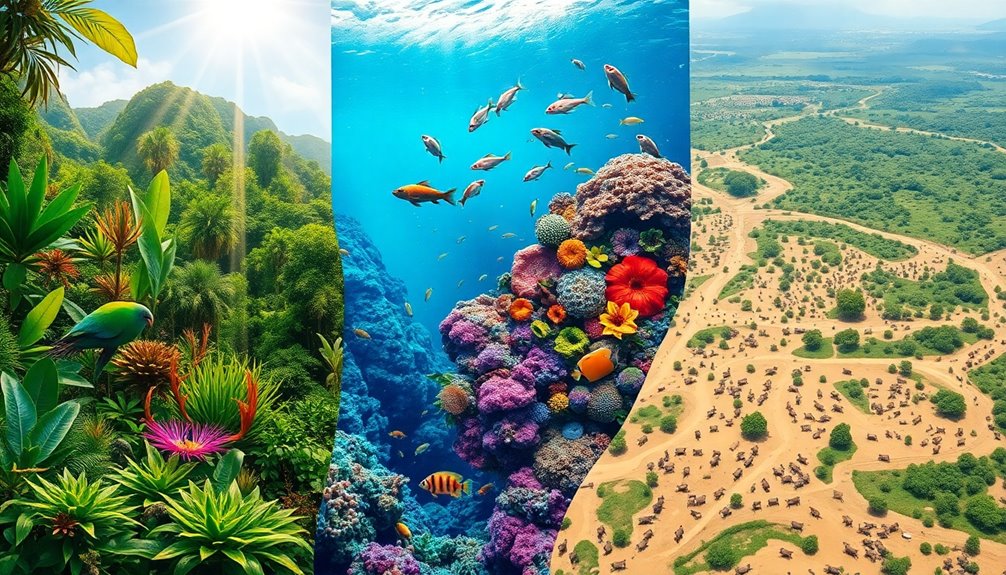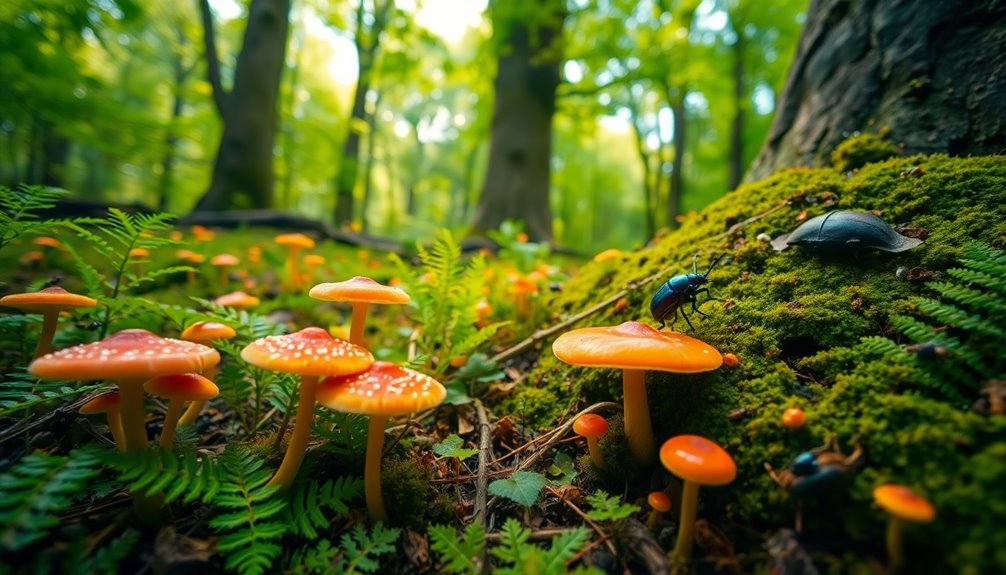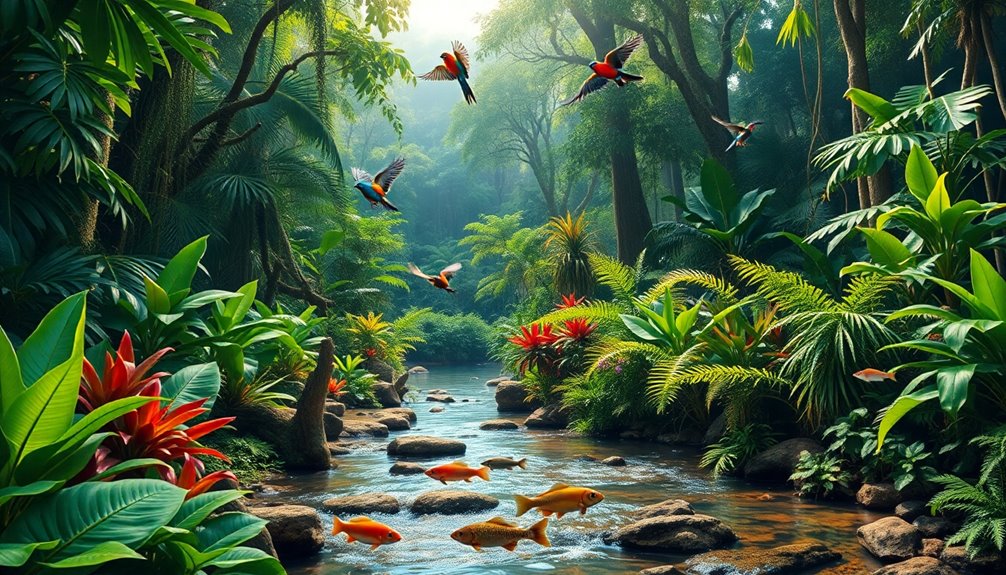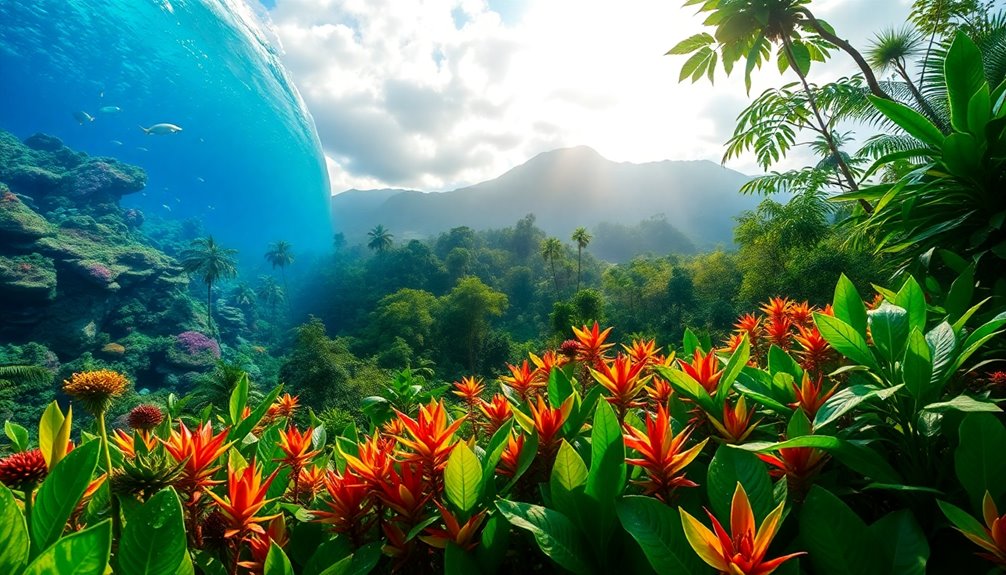Biodiversity consists of three main types: genetic diversity, species diversity, and ecosystem diversity. Genetic diversity refers to the variety within species, which helps them adapt and survive. Species diversity measures the number of different species in an area, essential for a balanced ecosystem. Ecosystem diversity includes the range of habitats that support various species and genetic diversity. Each type is important for sustaining life and ecosystem health, and there's so much more to explore on this fascinating topic.
Key Takeaways
- Genetic Diversity: Refers to the variability within species, crucial for their adaptability and survival in changing environments.
- Species Diversity: Measures the number of different species in an area, vital for maintaining healthy ecosystems and a stable food supply.
- Ecosystem Diversity: Encompasses various habitats that support a wide range of species and genetic diversity, contributing to ecological resilience.
- Importance: All three types of biodiversity are essential for ecosystem health and provide critical ecosystem services to humans.
- Conservation: Protecting these types of biodiversity is imperative for sustaining life on Earth and ensuring environmental balance.
What Is Biodiversity?

Biodiversity is a term that captures the incredible variety of life on Earth. It encompasses all living organisms, their genetic differences, and the ecosystems they form part of.
You might be surprised to learn that there are about 8.7 million species, with a vast majority still unidentified. Biodiversity includes three main types: genetic diversity, which refers to the variability within species; species diversity, highlighting the variety of different species; and ecosystem diversity, showcasing the range of ecosystems.
Understanding the importance of biodiversity is vital, as it maintains ecosystem health, stability, and resilience. The loss of biodiversity can threaten ecological balance, food security, and the essential ecosystem services that sustain life on our planet.
Types of Biodiversity

Understanding biodiversity isn't just about recognizing the variety of life on Earth; it also involves exploring its different types.
There are three main types of biodiversity: genetic diversity, species diversity, and ecosystem diversity. Genetic diversity refers to the variety of genes within a species, essential for adaptability and survival.
Species diversity measures the number of different species in an area, supporting critical ecosystem services like pollination and nutrient cycling.
Ecosystem diversity encompasses the variety of habitats, which contributes to stronger species and genetic diversity. Together, these types guarantee ecological health, climate resilience, and sustainable food systems.
Protecting biodiversity is imperative for our well-being, as it underpins the services that nature provides us every day.
Genetic Diversity

Genetic diversity is essential for a species' adaptability, allowing populations to thrive amidst changing environments.
However, threats like habitat loss and modern agriculture practices have greatly reduced this diversity, putting food security at risk.
Understanding these challenges is important for conserving genetic resources and ensuring ecosystem resilience.
Importance for Adaptability
While many factors influence a population's ability to adapt, the variety of genes within that population is essential for survival in changing environments.
Genetic diversity enhances adaptability and plays a key role in ecosystem resilience. Here's why it matters:
- Disease Resistance: A genetically diverse population can better withstand diseases and pests.
- Environmental Stress: Varied genetics enable species to cope with climate changes and habitat alterations.
- Food Security: Protecting genetic diversity in crops guarantees sustainable agricultural practices.
Without this genetic diversity, populations risk inbreeding, increasing the chance of extinction.
Sadly, about 75% of plant genetic diversity on farms has diminished, threatening both food security and ecosystem health.
Threats to Genetic Diversity
As agricultural practices evolve, the threats to genetic diversity have become increasingly pronounced. The dramatic 75% decrease in plant genetic diversity on farms poses a severe risk to global food security. Monocultures, like Cavendish bananas, heighten vulnerability to diseases. Loss of genetic diversity leads to inbreeding, raising extinction risks and reducing populations' resilience to environmental changes.
| Threat | Impact |
|---|---|
| Monocultures | Increased disease vulnerability |
| Reduced Genetic Variety | Lower adaptability to environmental changes |
| Inbreeding | Higher extinction risks |
| Loss of Ecosystem Services | Deterioration of ecosystem health |
Protecting genetic diversity is essential for sustaining ecosystem services and ensuring the adaptability of species in a rapidly changing world.
Species Diversity

Species diversity plays a vital role in maintaining healthy ecosystems and supporting our food supply.
However, this diversity faces significant threats from habitat loss, climate change, and pollution.
Understanding the importance of species diversity and the challenges it encounters is essential for effective conservation efforts.
Importance of Species Diversity
A diverse array of species plays an indispensable role in maintaining the stability and resilience of ecosystems.
When you consider the variety of species present, you'll find that biodiversity plays a significant part in:
- Pollination: Nearly three-quarters of plant species rely on pollinators, linking species diversity to food security.
- Nutrient Cycling: Diverse species contribute to healthy nutrient cycles, important for agricultural productivity.
- Pest Control: High species diversity helps regulate pest populations, reducing the need for chemical interventions.
However, habitat loss threatens this diversity.
The decline in species, particularly among pollinators like bees, can lead to significant food system failures and reduced crop yields.
It's essential to prioritize conservation efforts to maintain ecosystem health and functionality.
Threats to Species Diversity
Threats to species diversity are numerous and alarming, with an estimated 1 million species facing extinction due to habitat destruction and fragmentation.
Human activities, like deforestation and urban development, lead to significant habitat loss, directly impacting many species. Climate change further complicates things, altering ecosystems and making it hard for some species to adapt quickly enough to survive.
Pollution also plays a role, degrading habitats and harming species' health and reproduction. Invasive species compete with native organisms for resources, often causing declines in indigenous populations.
Additionally, overexploitation, such as overfishing and poaching, puts immense pressure on vulnerable species, pushing them closer to extinction.
Addressing these threats is essential to preserving our planet's rich species diversity.
Ecosystem Diversity

While ecosystems vary widely across the globe, their diversity is fundamental for maintaining biodiversity and environmental health.
Ecosystem biodiversity includes various habitats and ecological processes that support life. Here are three key aspects of ecosystem diversity:
- Habitat Diversity: Different environments, like forests and coral reefs, provide unique homes for countless species.
- Species Richness: Diverse ecosystems support a greater variety of species, enhancing resilience against changes.
- Ecological Processes: These ecosystems play significant roles in nutrient cycling and climate regulation.
Protecting ecosystem diversity is imperative, as human activities threaten it through habitat destruction and pollution.
Importance of Biodiversity

Ecosystem diversity directly impacts the significance of biodiversity in our world. A rich variety of species diversity strengthens ecosystem stability, making it more resilient to changes like climate shifts and pollution.
This biodiversity provides essential ecosystem services, including water purification, air regulation, and nutrient cycling, which are fundamental for your survival and well-being. Genetic diversity guarantees a range of nutritious food sources and medicinal resources derived from plants and animals.
High species diversity, especially in agriculture, supports productivity by relying on critical pollinators like bees, valued at about $14.6 billion annually in the U.S.
Additionally, protecting biodiversity enriches your cultural experiences and maintains the ecological functions that underpin diverse cultural practices and livelihoods.
Threats to Biodiversity

Biodiversity faces numerous challenges that threaten the delicate balance of our planet's ecosystems. Here are three major threats you should know:
- Habitat Destruction: Agricultural expansion and urbanization destroy natural habitats, leading to species loss.
- Climate Change: Altered habitats and shifting species distributions due to climate change can push vulnerable species toward extinction.
- Pollution: Contaminants like plastic waste and chemical runoff harm wildlife and disrupt ecosystem health.
Additionally, overexploitation through overfishing and poaching reduces populations, while invasive species outcompete native species, decreasing biodiversity.
Recognizing these threats is vital for fostering a sustainable future and protecting our planet's precious ecosystems.
Biodiversity Hotspots

Around the globe, there are 36 recognized biodiversity hotspots that play a significant role in conservation efforts. These regions contain at least 1,500 endemic species of vascular plants, making them essential for preserving our planet's biological richness.
Biodiversity hotspots are characterized by high species richness but face threats from human activities like deforestation and urbanization. Protecting these areas is fundamental, as they provide important ecosystem services, including water purification and climate regulation.
You can contribute to conservation efforts by supporting habitat preservation initiatives that aim to restore and protect these unique environments. By safeguarding biodiversity hotspots, we help maintain the ecological balance necessary for the survival of countless species, including those that depend on these habitats for their existence.
Conservation and Biodiversity

While many people may not realize it, conservation efforts are vital for maintaining the delicate balance of nature and protecting the planet's rich diversity of life.
To effectively safeguard biodiversity, consider these key strategies:
- Protect biodiversity hotspots to preserve unique ecosystems.
- Implement conservation strategies that restore habitats and promote species and genetic diversity.
- Adopt sustainable practices to minimize human impact on ecosystem services like clean air, water, and food production.
These actions are essential as the loss of biodiversity disrupts vital services and threatens resilience against climate change.
Global initiatives, like the Convention on Biological Diversity, highlight the significance of these measures for both ecosystems and human well-being.
Your involvement can make a difference!
Frequently Asked Questions
What Are the 3 Different Types of Biodiversity?
You're asking about the three different types of biodiversity.
First, there's genetic diversity, which involves the variety of genes within a species, vital for survival and adaptation.
Next, species diversity measures the number of different species in an area, supporting ecosystem functions.
Finally, ecosystem diversity includes the variety of habitats, contributing to the overall health of the environment.
Each type is essential for maintaining balance and supporting life on Earth.
What Are the 3 Components of Biodiversity and Discuss Each?
You'll find that biodiversity consists of three key components: genetic diversity, species diversity, and ecosystem diversity.
Genetic diversity guarantees populations can adapt and survive, while species diversity encompasses the variety of organisms in an area, crucial for ecosystem functions like pollination.
Ecosystem diversity includes different habitats, each contributing to overall health and stability.
Protecting these components is indispensable for sustainability, food security, and resilience against climate change impacts.
What Are the Three Major Principles of Biodiversity?
Imagine a garden thriving with a variety of plants, each contributing to its beauty and health.
Similarly, the three major principles of biodiversity are essential to our planet. You've got genetic diversity, which guarantees species can adapt; species diversity, reflecting the number of different species that create ecological balance; and ecosystem diversity, showcasing the various habitats that support life.
Together, these principles work like a well-tended garden, nurturing resilience and stability in nature.
What Are the Three Ways to Define Biodiversity?
You can define biodiversity in three main ways.
First, there's genetic diversity, which showcases the variety of genes within a species, critical for adaptability.
Then, you have species diversity, measuring the number of different species in an area, essential for ecosystem stability.
Finally, ecosystem diversity highlights the variety of habitats and ecological processes, supporting unique species and providing indispensable services like nutrient cycling and climate regulation.
Each aspect is interconnected and fundamental for a healthy planet.
Conclusion
Understanding the three types of biodiversity—genetic, species, and ecosystem diversity—helps you appreciate the intricate web of life around you. Each type plays an essential role in maintaining balance and resilience in nature. As you consider the importance of biodiversity, ask yourself: what would our world look like without the rich variety of life that sustains us? By recognizing the threats and supporting conservation efforts, you can make a difference in preserving this important treasure for future generations.









